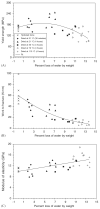The influence of water removal on the strength and toughness of cortical bone
- PMID: 16488231
- PMCID: PMC1941695
- DOI: 10.1016/j.jbiomech.2005.01.012
The influence of water removal on the strength and toughness of cortical bone
Abstract
Although the effects of dehydration on the mechanical behavior of cortical bone are known, the underlying mechanisms for such effects are not clear. We hypothesize that the interactions of water with the collagen and mineral phases each have a unique influence on mechanical behavior. To study this, strength, toughness, and stiffness were measured with three-point bend specimens made from the mid-diaphysis of human cadaveric femurs and divided into six test groups: control (hydrated), drying in a vacuum oven at room temperature (21 degrees C) for 30 min and at 21, 50, 70, or 110 degrees C for 4 h. The experimental data indicated that water loss significantly increased with each increase in drying condition. Bone strength increased with a 5% loss of water by weight, which was caused by drying at 21 degrees C for 4 h. With water loss exceeding 9%, caused by higher drying temperatures (> or =70 degrees C), strength actually decreased. Drying at 21 degrees C (irrespective of time in vacuum) significantly decreased bone toughness through a loss of plasticity. However, drying at 70 degrees C and above caused toughness to decrease through decreases in strength and fracture strain. Stiffness linearly increased with an increase in water loss. From an energy perspective, the water-mineral interaction is removed at higher temperatures than the water-collagen interaction. Therefore, we speculate that loss of water in the collagen phase decreases the toughness of bone, whereas loss of water associated with the mineral phase decreases both bone strength and toughness.
Figures




References
-
- Broz JJ, Simske SJ, Greenberg AR. Material and compositional properties of selectively demineralized cortical bone. Journal of Biomechanics. 1995;28:1357–1368. - PubMed
-
- Casciani FS. Identification of hydrate water in enamel, dentine, cementum, and bone. In: Fearnhead RW, Stack MV, editors. Tooth Enamel II: Its Composition, Properties, and Fundamental Structure. John Wright & Sons, Ltd.; Bristol: 1971. pp. 14–23.
-
- Chernick MR. Bootstrap Methods: A Practitioner's Guide. While: New York: 1999.
-
- Currey JD. Anelasticity in bone and echinoderm skeletons. Journal of Experimental Biology. 1965;43:279–292.
-
- Currey JD. The effect of porosity and mineral content on the Young's modulus of elasticity of compact bone. Journal of Biomechanics. 1988;21:131–139. - PubMed
MeSH terms
Grants and funding
LinkOut - more resources
Full Text Sources
Other Literature Sources

